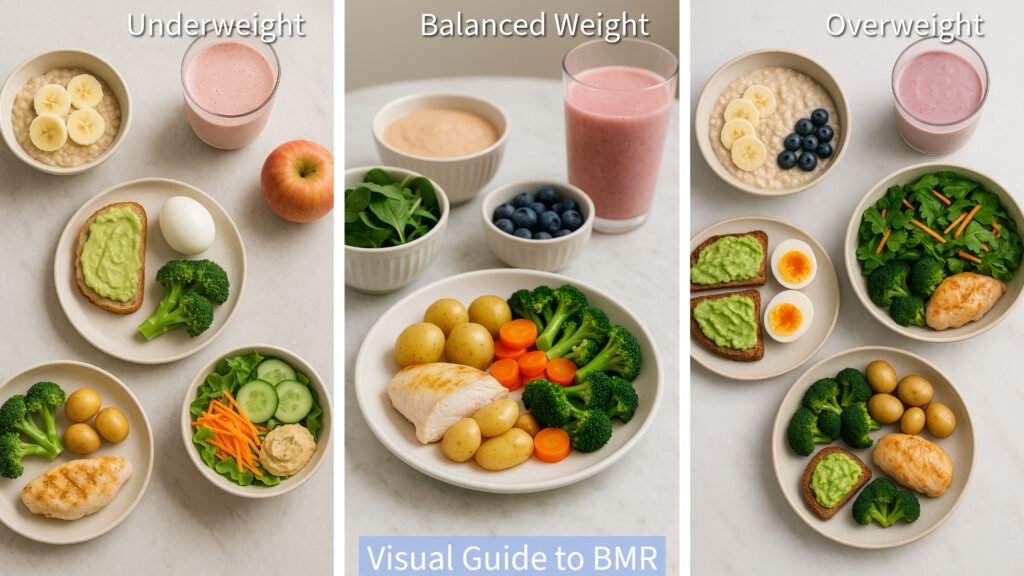Why It’s Important for Your Health

Have you ever wondered how many calories your body needs just to rest? Without any movement.
You’re simply resting, not walking, not exercising, not even working, just naturally breathing. Your body is healing, digesting, and simply being. It can be surprisingly eye-opening to learn.
This quiet outcome is called our Basal Metabolic Rate, or BMR for short. It helps reveal how many calories your body needs while resting, doing absolutely nothing other than resting and breathing naturally.
This is a beginner’s guide, here to help you understand what BMR really means, why it matters, and how your unique daily number — in calories — can gently support a more mindful and balanced approach to health.
I share with you images that are only meant as a guide, in the hope they may help you visualise how much food exactly your body requires while resting. Obviously, this varies for everyone, depending on your unique calculations, so I shall share what calculations I used for these.

Based on a young female, age 21, height 5’4″
🌼 Underweight
Weight: 7 stone / 98 lbs / 44.5 kg
BMR: ~1226 kcal/day
🌿 Balanced Weight
Weight: 8 stone / 112 lbs / 50.8 kg
BMR: ~1290 kcal/day
🌻 Overweight
Weight: 11 stone / 154 lbs / 69.9 kg
BMR: ~1480 kcal/day
Why Knowing Your BMR Really Matters
Imagine for a moment if everyone were to be aware of their unique Basal Metabolic Rate, this isn’t just about numbers that may or may not confuse us. But it’s about learning how to nurture a relationship with your body and, step by step, how to care for it with kindness.
Your BMR is the quiet hum of life within you. The energy our body needs to be able to keep your heart beating, your lungs breathing, your cells naturally repairing, and your peace of mind. Even as you sit still, your body is working gently behind the scenes to keep you alive and well. Isn’t that fascinating!?
When you know your BMR, something beautiful happens:
You begin to realise that food isn’t just… whatever we fancy! (Though yes, cake for me does call out sometimes! 😄)
It’s actually one of the most powerful ways we can show ourselves care and respect. What we eat — and when we eat — truly supports our body in staying balanced, nourished, and calm.
As the old saying goes, “we are what we eat,” and with just a little awareness, we can begin to choose foods that honour our body’s needs, not from a place of habit or guilt, but from a place of self-love. Wouldn’t that be lovely!?
When we begin to care for our bodies with awareness and kindness, something even bigger, hopefully, starts to take flight. That, my friends, is kind respect for others, as we learn how beautifully unique we all are individually. Now imagine if we were taught this at a young tender age at school.
We start to see others — and the world around us — with more empathy, too.
Wellness stops being a competition… and becomes a gentle, shared journey.
From Resting to Living: Understanding TDEE
Once you’ve discovered your BMR — the energy your body uses only at rest — the next step is to learn how much energy you use while living. This is when it becomes more of a challenge, and it’s called your TDEE, or Total Daily Energy Expenditure.
TDEE is how much more nutrition your body needs, including your BMR, for all the extra energy you use moving throughout the day, either walking, dancing, thinking, cooking, playing, or even fidgeting on your bottom! It’s the full picture of your daily energy needs, unique to your lifestyle and rhythm.
Knowing your TDEE helps you better relate to your unique requirements:
- How much food supports your everyday life
- How different activities use energy in beautiful ways
- Why no two people have the same daily needs — and that’s okay!
As it’s not about counting every bite, or measuring each step. It’s more about learning to listen to our body’s whispers gently inside.
To honour our energy with kindness, nourish, to rest, and to move with joy — no need to follow any rules. This is more of a guide, it isn’t a checklist or a chore. More of a soft invitation towards awareness, no pressure at all.
And as you may grow more curious, you might even begin to play…
Swapping this for that, just to see how it feels.
Little treats that don’t feel like sacrifices, just small acts of care.
These aren’t musts or shoulds — just possibilities to explore.
So choose what delights you. Let the fun begin, let it be yours.
✨ Kind-to-Body Treats That Still Feel Like Treats ✨
- Crisps → Try roasted chickpeas with a sprinkle of gentle herbs or a hint of paprika
- Ice cream → Frozen banana blended with a spoonful of coconut yoghurt and a dash of cinnamon
- Sweets → Medjool dates or dried mango slices dipped in melted dark chocolate
- Sugary drinks → Chilled herbal infusions (like dandelion or chamomile) with lemon or berry slices
- Chocolate bars → Did you know that dark chocolate is actually known to be a healthy treat, in moderation of course, added with a few raspberries, or dipped dried mango
- Biscuits → Homemade oat cookies with mashed banana, sunflower or pumpkin seeds, and a drizzle of honey
These are gentle, joyful alternatives that don’t feel like a sacrifice — they’re simply ways to love your body and your taste buds, without discomfort or worry. So enjoy!
Always make sure to check ingredient labels carefully, especially when trying something new, and remember, what works for one may not always work for someone else. As we are all beautifully unique, we have to think about those who may have allergies.
Our aim is to always gently offer guidance, as life is never one-size-fits-all.
